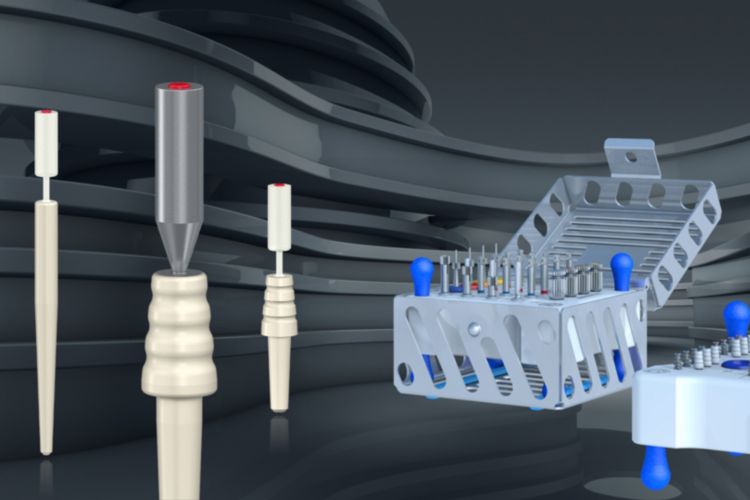Brasseler is a leader in the medical technology space
If a trip to the dentist makes you nervous, you’re probably not alone. But if there’s one thing you can feel confident about, it’s the craftsmanship and quality of the tools your dentist is likely using.
Headquartered in Lemgo, Germany, Gebr. Brasseler GmbH & Co.KG is a medical technology company with over 90 years of experience in high-quality medical and dental tools and technology. Under the Komet brand, they design and manufacture the world’s largest portfolio of rotating dental instruments and systems. Additionally, their Komet business unit produces motor-driven precision tools for use in surgical drive systems.
As a family-founded and owned company, Brasseler maintains strong ties to community and is committed to integrating sustainable and social action into everyday business.
Creating precision designs can be time-consuming and costly
The process for designing and manufacturing tiny, precision dental tools takes an immense amount of focus—one misstep and the tool will not have the precise shape or angle needed to function accurately in the dentist’s hand. Tools of this size and nature require extremely complex geometries in the design stage, which can only be developed with powerful, advanced software.
Manufacturing products with complex geometries can be challenging because for some designs, the production equipment must remove precise, miniscule amounts of material to create the finished product. If incorrectly designed tools make it through manufacturing, the company loses time and money on tools that cannot ship to customers. Because of this, it’s important to have the tools designed accurately before reaching the manufacturing stage.

At Brasseler, the design department had previously relied on tools that lacked 3D parametric design capabilities. This limited their ability to create detailed, realistic designs, and consequently, much of the more detailed aspects of design work was finalized within the manufacturing department. That led to a lot of back-and-forth communications between the design and manufacturing teams, and ultimately longer lead times. For designers, that also meant a lot of tedious reworking of designs. What’s more, if more than one person had to work on a design, or some aspect of the work got passed around, there was no way to capture knowledge or steps of the process from person to person.
Brasseler knew that with the use of a parametric CAM solution, they could produce high-quality 3D designs and automate crucial parts of the design process, thereby increasing productivity and throughput—and set out to make a change with the right technology.
Brasseler uses Creo’s Numerical Control and 3D modeling capabilities to improve the design and manufacturing process
Name: Gebr. Brasseler GmbH & Co. KG
Founded: 1923
Industry: Medical instruments
Product brand: Komet
Production location: Lemgo, Germany
Company size worldwide: 1,372
Products: Approx. 30,000
Countries supplied worldwide: 105
Customers worldwide: 64,689
Brasseler turned to Creo’s 3D CAM to optimize their design processes with more advanced 3D designs. Creo NC is part of PTC’s Creo line of design software, which delivers a comprehensive suite of 2D and 3D solution capabilities supporting computer-aided design (CAD) and computeraided manufacturing (CAM).
Creo offers a full-spectrum solution that helps maximize efficiencies from design through production, resulting in an array of beneficial outcomes for both manufacturers and customers. Potential benefits include accelerated time to market, reduced product development costs, improved product quality, and increased customer satisfaction.
Creo NC’s advanced features have helped Brasseler improve their design and manufacturing process, allowing them to accomplish several important outcomes. First, the advanced 3D design capabilities allow Brasseler to more accurately define the complex geometries of the dental tool designs while still in the design stage. This is because they can perform all of the steps in one fluid sequence, testing and changing the geometry quickly without losing any previous work.
Brasseler can utilize design features that can be applied to many different models, parts, and products after only being defined once. Having more control in the design stage helps eliminate potentially costly errors and miscommunication downstream, thereby saving valuable time. “Creo’s design features help us standardize our most complicated design processes,” says Kornej Nickel, Coordinator of Digital Manufacturing at Brasseler. “This saves a lot of time, especially when working with an intricate model.”
Additionally, Creo NC has a broad range of tool path capabilities. Creo NC allows the user to specify the tools and tool paths that will be used to machine the finished part. If a design change needs to be made to the 3D design, the seamless integration saves a lot of re-work and helps reduce future errors because Creo NC will automatically recalculate the tool path for you, saving an immense amount of time.
Creo NC also has excellent process planning automation-related capabilities such as manufacturing templates that make all of this possible. The manufacturing templates act as containers, allowing users to capture the information necessary to reuse an NC tool path. This functionality allows the user to create an unlimited and self-defining library in a way that the manufacturing department can easily read and share data. Notably, the containers help capture knowledge from the more experienced programmers in the company, so junior manufacturing engineers can see and reuse best practices—resulting in greater consistency across the organization. The manufacturing templates can be stored in a library so they can be placed over and over again without having to create toolpaths according to standard practices. They allow the user to easily and quickly create complex toolpaths, measurements, and sequences. The automation saves time, which increases productivity.
Kornej Nickel
Coordinator of Digital Manufacturing at Brasseler
Finally, Creo’s post-process generator, called Gpost, allows operators to configure postprocessors for any machine and produce as many posts as they need. Gposts provide the user with a post-processor generator that is not only free in each Creo CAM license, but also easy to use and learn—and allows them to make as many posts as they want. Unlike other CAM solutions, Creo’s post-processor can be configured for any machine by the user.
Brasseler sees increased productivity and improved knowledge sharing
With Creo NC, Brasseler has begun seeing significant improvements to their design and manufacturing process. They’ve been able to drastically reduce the amount of time it takes to produce a finalized design that is ready for manufacture, in some cases going from half a day to just a few minutes.
They’re also able to get more function out of their machines now, versus only using the somewhatlimiting software that often comes installed on their equipment. This increased machine function helps them speed time to market with new and enhanced tools. “Right now, we have full freedom of design, and we can use the full capability of each machine,” says Dirk Schlinkmann, Demand Manager in Information Technology at Brasseler.
Dirk Schlinkmann
Demand Manager in Information Technology at Brasseler
“With Creo NC’s automation capabilities, we can even build the exact same product from one machine to the next, even if those machines have different controls or access,” he continues. “That’s a great advantage for our whole company. No one who uses default software from a machine manufacturer is able to do this as efficiently.”
Quality and innovation remain central to Brasseler’s future success
Moving forward, Brasseler is committed to continuous improvement and innovation for the highest quality work they can provide to customers. In particular, they’re eager to continue exploring the freedom to innovate on customer needs and the requests that customers bring to them—and their creative use of technology will help do that.
“We’re a family-driven company, and maintaining values is important to us,” explains Schlinkmann. “It’s essential to give our employees the freedom to be creative—and give them the tools to do so,” he continues. “That really sets us apart as a company and guides what we can do for our customers.”
With so many design and manufacturing improvements under their belts, Brasseler looks forward to serving the medical and dental communities—and easing the minds of patients— for many years to come.
